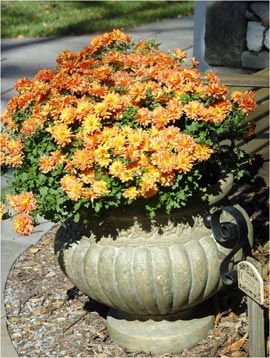The queen of fall flowers – the chrysanthemum or “mum” – often ends up as little more than a late-season throw-away. The brilliant flowers shine for a few weeks alongside the pumpkins and straw bales, then the plants get trashed as the waning sunshine sets on their browned tops. What a waste.
Not all gardeners are aware that most of the mums sold in garden centers – especially in summer and fall – are winter-hardy ones. These so-called “garden mums” usually survive winters down to Zone 5 and sometimes Zone 4.

With a little know-how, garden mums will come back reliably for many years.
- The first step is to make sure you’re buying a hardy garden mum in the first place. Less-hardy “florist mums” are grown as greenhouse plants, forced into full bloom and typically sold as gift plants, often in spring. Most of these are winter-hardy only down to Zone 7.
- A second winter-survivability consideration is not planting too late in the season. Because mums are one of the last perennial flowers to bloom, they’re typically not bought and planted until October—often to replace frost-killed summer annuals. Other times they’re not planted at all, instead being used as potted spots of color on decks, patios, porches and front steps. Left outside in above-ground pots, those plants almost always freeze-dry over winter. Mums that are planted in spring, summer or very early fall have a better chance of surviving winter. That earlier planting gives the roots a chance to acclimate and establish, increasing the plant’s winter hardiness. Roots that take hold before the ground freezes also prevent mums from “heaving” out of the ground in winter, leaving the top of the rootball exposed. That alone kills many a late-planted mum. Even if you like your mums potted in fall, it’s better to plant them late when the show’s over than not at all. Just water them well, mulch them with about 2 inches of bark mulch or chopped leaves, and tamp them back down ASAP if you find them heaving during winter freezes and thaws.
- The third key mum-wintering aid is waiting until spring to trim off the cold-killed foliage. Research has found that the crumbling dead foliage helps insulate the crowns of the plants and increases their cold tolerance. No matter when you plant garden mums, pick a sunny spot and work about an inch of compost, chopped leaves or similar organic matter into the loosened top 10 or 12 inches of your native soil. Those amendments will aid drainage and add organic matter and nutrition to the soil. Also work a balanced, granular fertilizer into the soil at planting time. Top the planted bed with 2 inches of mulch and then keep the soil consistently damp the first full growing season.
In ensuing years, start the growing season by trimming or pulling off the winter-killed foliage. Then scatter a once-a-season dose of fertilizer over the bed, freshen the mulch (if needed) and watch for new growth.
Early spring is also a good time to dig and divide mums—right before new growth occurs. Dividing is usually a good idea every two or three years. Cut the clumps into at least fist-sized pieces. For large plants that seem to be dying out in the center, keep divisions from around the perimeter and discard the middle. To keep mums from flopping over under the weight of their bountiful fall flowers, keep the plants cut back to about 6 inches until late June or early July. Go ahead and shear them. You don’t have to “pinch” each stem one by one as some people think. You may need to cut your plants two or even three times before letting them proceed into their flowering phase in mid to late summer. The result will be compact, non-flopping plants with heavy and more uniform blooming.
Keep in mind that mums also are more prone to flop if grown in too much shade or in soil that’s overly loose and rich. Some varieties also are naturally more compact than others, so check the labels for shorties if you lean in that direction. Then have fun picking from the many colors and flower forms available in this popular perennials.
Yes, garden mums are perennials in most of the U.S. – not fall-blooming annuals.